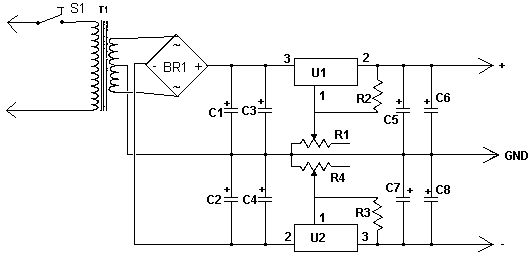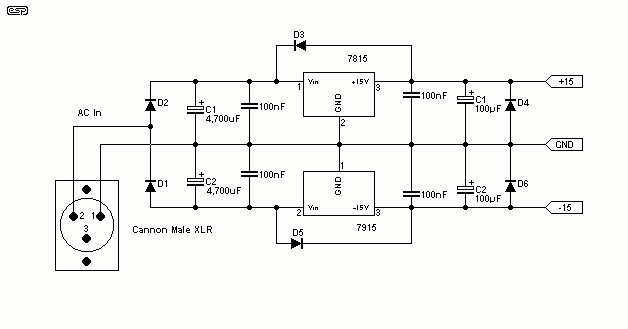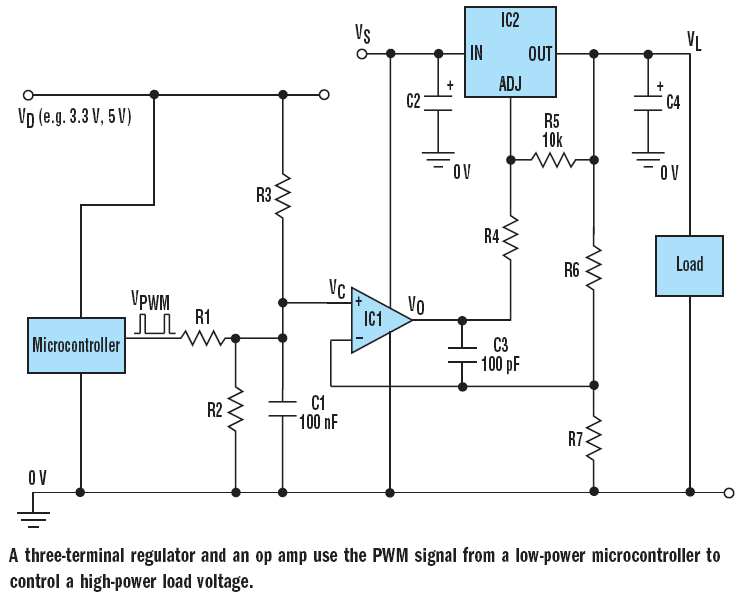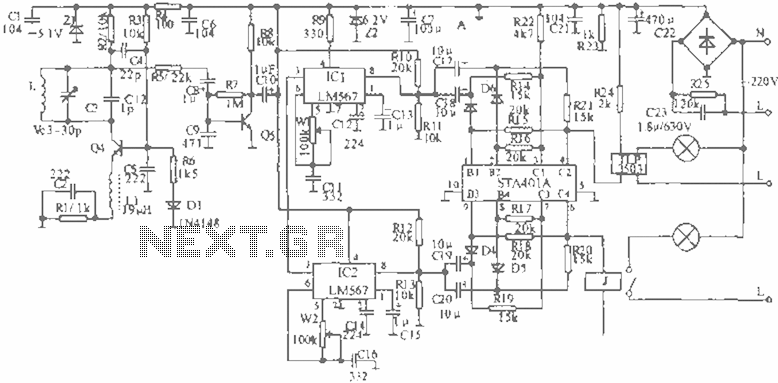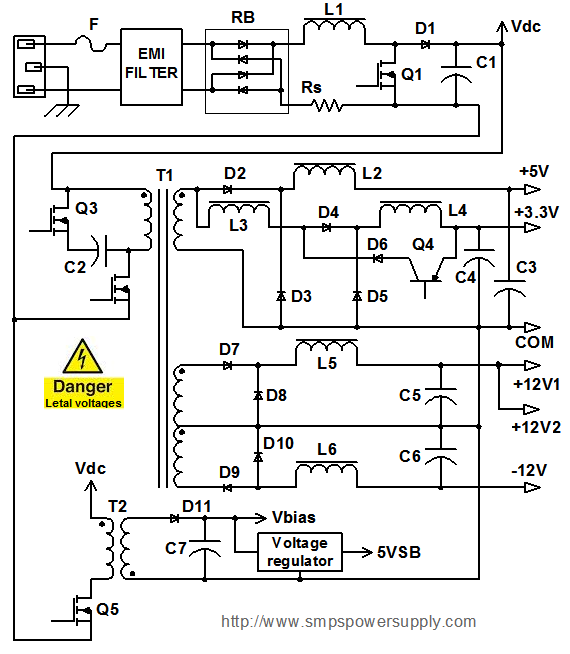
5V supply
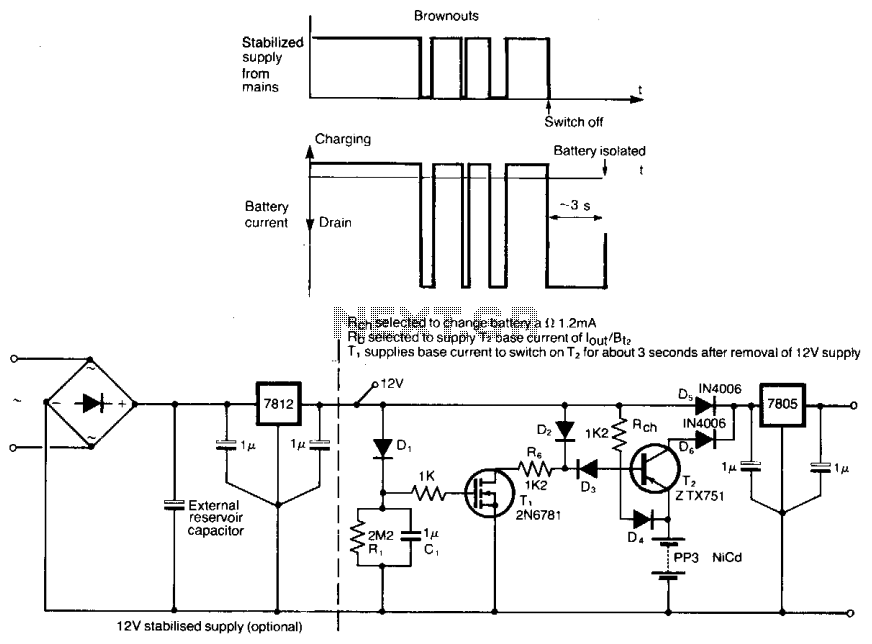
This circuit protects microprocessor systems from brownouts without the cost of an uninterruptible power supply. It is designed around a small 9-V nickel cadmium battery, which continues to provide a constant 5-V output during brownouts lasting up to a few seconds. Load currents of up to 500 mA can be drawn using the components shown. When the mains-derived supply is present, diode D5 is forward biased, allowing the stabilized supply to power the 5-V regulator and the circuitry to be protected. FET T1 is kept on by diode D1, with its drain current supplied from the DC source through resistor Rb and diode D2. Diode D3 is reverse-biased, ensuring that T2 remains off and the battery is isolated from D6.
RCH and diode D4 are used to trickle charge the battery at approximately 1.2 mA. When the 12-V supply is removed, resistor R1 and capacitor C1 initially keep T1 switched on. At this point, D3 becomes forward biased, allowing T1's drain current to flow through Rb, D3, and T2 from the battery. This action turns T2 on, permitting the load circuitry to draw current from the battery via D6 and the 5-V regulator. After a few seconds, capacitor C1 discharges through R1, causing the gate-source voltage (Vgs) to fall below the threshold for the FET, thus switching T1 off. Consequently, there is no longer a path for base current to T2, resulting in T2 also switching off and isolating the battery.
The circuit operates by utilizing a combination of diodes, resistors, and transistors to manage power supply transitions effectively. The presence of the 12-V mains supply enables the circuit to maintain the necessary voltage levels for proper operation of the microprocessor system. During brownouts, the circuit seamlessly transitions to battery power, ensuring continuous operation without interruption. The trickle charging mechanism ensures that the battery remains charged and ready for use when needed, while the design minimizes the risk of over-discharge by isolating the battery once the primary supply is restored. This arrangement provides a cost-effective solution for protecting sensitive electronic systems from temporary power outages.This circuit protects microprocessor systems from "brownouts" without the expense of an uninterruptible power supply. Designed around a small 9-V nickel cadmium battery the circuit continues to provide a constant 5-V output during brownouts of up to a few seconds.
Load currents of up to 500 mA may be drawn using the components shown. With this mains-derived supply present, D5 is forward biased so that the stabilized supply powers the 5-V regulator and hence the circuitry to be protected. FET Tj is held on by Dl, its drain current being provided from the dc supply via Rb and D2. Diode D3 is reverse-biased so that T2 is off, and the battery is isolated from D6. RCH and D4 serve to trickle charge the battery with approximately 1.2 mA. When the 12-V supply is removed, Rl and Cl initially keep Tl switched on. D3 is now forward biased, so that Tl drain current is drawn via Rb, D3 and T2 from the battery. This switches T2 on, allowing the load circuitry to draw current from the battery via D6 and the 5-V regulator. After a few seconds Cl has discharged (via Rl) such that Vgs falls below the threshold value for the FET, and Tl switches off.
There is then no path for T2 base current, so that it also switches off, isolating the battery.
RCH and diode D4 are used to trickle charge the battery at approximately 1.2 mA. When the 12-V supply is removed, resistor R1 and capacitor C1 initially keep T1 switched on. At this point, D3 becomes forward biased, allowing T1's drain current to flow through Rb, D3, and T2 from the battery. This action turns T2 on, permitting the load circuitry to draw current from the battery via D6 and the 5-V regulator. After a few seconds, capacitor C1 discharges through R1, causing the gate-source voltage (Vgs) to fall below the threshold for the FET, thus switching T1 off. Consequently, there is no longer a path for base current to T2, resulting in T2 also switching off and isolating the battery.
The circuit operates by utilizing a combination of diodes, resistors, and transistors to manage power supply transitions effectively. The presence of the 12-V mains supply enables the circuit to maintain the necessary voltage levels for proper operation of the microprocessor system. During brownouts, the circuit seamlessly transitions to battery power, ensuring continuous operation without interruption. The trickle charging mechanism ensures that the battery remains charged and ready for use when needed, while the design minimizes the risk of over-discharge by isolating the battery once the primary supply is restored. This arrangement provides a cost-effective solution for protecting sensitive electronic systems from temporary power outages.This circuit protects microprocessor systems from "brownouts" without the expense of an uninterruptible power supply. Designed around a small 9-V nickel cadmium battery the circuit continues to provide a constant 5-V output during brownouts of up to a few seconds.
Load currents of up to 500 mA may be drawn using the components shown. With this mains-derived supply present, D5 is forward biased so that the stabilized supply powers the 5-V regulator and hence the circuitry to be protected. FET Tj is held on by Dl, its drain current being provided from the dc supply via Rb and D2. Diode D3 is reverse-biased so that T2 is off, and the battery is isolated from D6. RCH and D4 serve to trickle charge the battery with approximately 1.2 mA. When the 12-V supply is removed, Rl and Cl initially keep Tl switched on. D3 is now forward biased, so that Tl drain current is drawn via Rb, D3 and T2 from the battery. This switches T2 on, allowing the load circuitry to draw current from the battery via D6 and the 5-V regulator. After a few seconds Cl has discharged (via Rl) such that Vgs falls below the threshold value for the FET, and Tl switches off.
There is then no path for T2 base current, so that it also switches off, isolating the battery.
